Falkirk and District Tramways
History
Powers to build a 4ft 0ins-gauge overhead electric tramway were acquired on the 2nd July 1901 under the Falkirk and District Tramways Order Confirmation Act 1901; the same act also incorporated a company to build and operate the tramway, the Falkirk and District Tramways Company. Although the promoters had secured the buy-in of the various local authorities — chief amongst them Falkirk Town Council — they now struggled to secure the finance to construct the tramway, the costs of which were higher than usual due to the requirement to completely rebuild three bridges (two canal bridges and a road bridge).
Three years later, in May 1904, Bruce Peebles and Company of Edinburgh secured an option to take over the existing powers, and duly formed a new company — the Falkirk Electric Construction Syndicate Limited — on the 24th October 1904 to build and operate the tramway. The decision to build the tramway would have made eminent business sense to BP&Co, as they had just built a large electricity generating station at nearby Bonnybridge — operated by its subsidiary, the Scottish Central Electric Power Company — that would supply power for the tramway.
Construction started in early 1905, with the first overhead electric services commencing on the 21st October 1905. As constructed, the line was a circuit of just over six miles, though it couldn't initially be operated as such due to the objections of the Caledonian Railway Company — the owners of the Forth and Clyde Canal — which took issue with the configuration of the two new swing bridges over the canal. Modifications were eventually made, the full tramway circuit opening on the 12th March 1906; the initial services were provided by 18 tramcars.
Passenger loadings were very healthy, and the owners lost no time in applying for powers to build extensions to Grangemouth and Lauriston; these were granted on the 21st December 1906 under the Falkirk and District Tramways (Extensions) Confirmation Act 1906, both to be built within five years.
Construction of the Lauriston extension did not commence until June 1909, possibly due to the company being involved in heavy expenditure during 1908, having to completely rebuild the first 15 tramcars, which though barely three years old, were not up to the rigours of the Falkirk weather, or it would seem, their core purpose of delivering a tramway service, given that they had to have their motors and controllers replaced too.
Services over the new branch to Lauriston commenced on the 3rd September 1909, taking the tramway to its final size of 7.45 miles. From the High Street in Falkirk, the main line ran northwestwards through Bainsford to Carron, where it crossed the river, before running westwards through Goshen (Stenhousemuir) to Larbert, whereupon it turned southeastwards past the depot at Carmuirs to Camelon, thence eastwards back to Falkirk High Street. The branch to Lauriston ran eastwards from Falkirk High Street to a terminus at Mary Square.
The powers for the extension to Grangemouth were allowed to lapse, and though they were subsequently revived on the 25th June 1912 under the Falkirk and District Tramways Order Confirmation Act 1912, the line was never built, possibly because of the insistence — by Grangemouth Town Council — that the line should run through a sparsely populated, and therefore unremunerative area to the town's eastern boundary. Even without the extension to Grangemouth, the tramway was very successful financially, paying dividends of 4 to 5 % annually.
The company elected — on the 22nd May 1914 — to change its name to that of its predecessor, the Falkirk and District Tramways Company.
The company had meanwhile dipped its toes in the water of motorbus operation, introducing its first charabanc service on the 21st January 1913. This was followed one year later (on the 1st January 1914) by its first regular motorbus services, which operated between Falkirk and Grangemouth, a move that effectively put an end to the proposed tramway between the towns.
Like the vast majority of tramways in the United Kingdom, the F&DT suffered during the Great War from loss of men (and their skills) to the armed services. As a consequence, maintenance suffered, particularly as the workshop facilities on the system were always limited. As a result, the system emerged from the conflict in run-down condition, with a significant backlog of maintenance and renewals. Despite these challenges, the tramway was in a healthy state financially, carrying 5 million passengers during 1919, enabling a 7% dividend to be paid.
1919 also saw a commitment to expansion of the company's bus operations, with the establishment on the 10th February off a sister company, the Scottish General Omnibus Company. This step was presumably taken because the F&DTCo only had powers to operate motorbus services in conjunction with the tramway services. The final details of the separation of the two entities were agreed in December 1919, with the vesting of the motorbus operation in the SGOCo being backdated to the 16th August 1919. The SGOCo then expanded throughout the 1920s, introducing new services and taking over several of its local competitors.
A major change took place in April 1920 when both the F&DTCo and the SGOCo were sold to the Fife Tramway, Light and Power Company, a subsidiary of Balfour Beatty and Company. This brought significant investment to the tramway, track reconstruction commencing in 1921 (including much doubling) and continuing in sections through to 1927, at which point the entire system had been dealt with. The Lauriston branch, however, had been subject to intense independent motorbus competition, such that it was not renewed, the trams running for the last time on the 20th July 1924.
In 1925, the F&DTCo's parent company, the FTL&PCo, placed the operation of its Dunfermline trams and buses under the management of the F&DTCo and the SGOCo, respectively. This was followed four years later, by the sale of its electricity generation and supply operations to the Scottish General Power Company (in July 1929), leaving it with just its tram and motorbus operations in Falkirk and Dunfermline.
Investment continued in the two tramway systems, the first of 16 new Pullman tramcars entering service in Falkirk on the 28th August 1929, the remainder arriving between 1929 and 1931. In 1929, the F&DTCo (as well as various other BB&Co tramway subsidiaries) attempted to constrain motorbus competition through an act of parliament; the bill attracted several powerful objectors, and was therefore largely unsuccessful, though it did authorise — on the 26th July 1929 under the Falkirk and District Traction Order Confirmation Act, 1929 — a change of name to the Falkirk and District Traction Company.
In June of the following year, the FTL&PCo sold the SGOCo (and Dunfermline omnibuses) to the Scottish Motor Traction Company, which vested these in its subsidiary, W Alexander and Sons Limited.
The tramway, which had been throughly modernised, continued its profitable existence, adding four more secondhand but modern tramcars in 1934. The future may have seemed fairly rosy, but the SMTCo had other ideas, and in 1935 it made an offer to the FTL&PCo that the latter felt it had to recommend to its shareholders. By June 1935, almost all the shares in the F&DTCo had been sold to the SMTCo, which thereupon announced that the system would close (seemingly with little of no consultation), despite it being modern and profitable.
The SMTCo therefore proceeded to run the trams down, the last tram of all running on the 21st July 1936, but returning to the depot in the early hours of the following day.
Uniforms
Photographs taken in the first few years of operation show that conductors and motormen wore double-breasted, lancer-style tunics with five pairs of buttons (narrowing from top to bottom), epaulettes and high fold-over collars; the latter bore company initials — 'F&DTC' — on both sides, in embroidered script lettering. The buttons also bore 'F&DTC' in script-lettering, though the material used remains unknown, as an example is yet to come to light. The tensioned-crown peaked caps bore an oval cloth cap badge with embroidered company initials — 'F&DTC' — above the grade, either 'CONDUCTOR' or 'MOTORMAN' (all in block letters). Tramcar crews also wore an oval badge on the left breast of their tunics, which had the bearer's grade — either 'MOTORMAN' or 'CONDUCTOR' — above an employee number. It is currently unclear whether these badges were issued in brass or nickel. This particular style of badge was also used by Sunderland District Electric Tramways (see link) and Bath Electric Tramways Limited (see link), as well as some of London's underground railways.
The style of uniform underwent several changes over the years, the first of which appears to have taken place relatively early on, probably in the late-Edwardian era. Although surviving photos are far from conclusive, they suggest that single-breasted jackets were now issued; these had five buttons, two breast pockets (with button closures), epaulettes and high fold-over collars; the latter appear to have been devoid of insignia. Although the caps remained the same, the cloth cap badge was replaced by a standard, off-the-shelf, script-lettering grade badge — either 'Conductor' or 'Motorman' — though whether these were nickel or brass is currently unclear.
The uniforms appear to have been changed yet again around the time of the Great War, back to a double-breasted, lancer style, but with epaulettes and stand-up collars; the latter now carried system initials — 'F D T C' — in individual metal letters. At some point, probably following the take-over by the FTL&PCo in April 1920, a change also appears to have been made to the buttons, which were from then on plain with a scalloped rim (see link). The jackets were changed one last time, probably in the late 1920s, to a single-breasted design, with four buttons and lapels; the latter usually carried 'F D T' on the bearer's right-hand side.
Tramcar crews were also issued with greatcoats. It is unclear what form these took in the early years, though in later years they were certainly double-breasted with four pairs of buttons, and lapels; they appear not have carried insignia of any kind.
Senior staff were issued with double-breasted jackets with four pairs of buttons (the top pair buttoning between the collars and the lapels); the collars bore embroidered script-lettering, either company initials or the grade — photographic evidence is unfortunately inconclusive. The tensioned-crown peaked caps bore an oval cloth badge, which probably bore the grade. In later years, the jackets remained double-breasted with four pairs of buttons, but the collars now carried the grade — either 'Ticket Inspector' or 'Chief Inspector' — in two rows of script lettering. The cap badges were oval cloth with the grade in embroidered script lettering — 'Inspector', 'Ticket Inspector' or 'Chief Inspector'; although 'Inspector' was used on the cap badges, the full grade of 'Ticket Inspector' appears to have been used on the jackets. Senior staff were also issued with double-breasted overcoats — these probably bore company/system initials or a grade on the collars.
Female staff were employed as conductresses during the Great War to replace male staff lost to the armed services; in common with many eastern Scottish tramway systems, and unlike the vast majority elsewhere in the UK, Falkirk retained their services right through to closure in the mid 1930s. The first conductresses were set on in June 1915, with motorwomen following a year later in June 1916. Lady conductors (as they were known) were issued with long single-breasted jackets with five buttons, lapels and a waist belt (see below), along with a long matching skirt. The collars appear to have carried a designation in embroidered script initials, possibly 'FDTC'. Baggy peaked caps were worn, which came to be known as motor caps; these had a glossy peak and carried a standard script-lettering grade badge, though the latter were often replaced with regimental badges, a common practice during the Great War. The ladies were also issued with single-breasted topcoats with a row of five buttons off-set to one side, epaulettes and fold-over collars; the latter bore 'F D T' on both sides in individual metal initials. In later years, a more robust double-breasted jacket was worn with five pairs of buttons, epaulettes and high fold-over collars, once again devoid of badges.
In the last few years of operation, Falkirk's ladies were issued with stylish gabardine-like coats with lapels and collars of a darker colour than the main garment. These appear to have existed in two varieties: the first single-breasted and light in colour (possibly white), and a single-breasted darker version, possibly of a waterproof material.
The F&DTCo also employed the services of at least one inspectress during the Great War; photographs of this individual appear not to have survived, so the details of the uniform that she presumably wore remain unknown.
Further reading
For a detailed account of the tramway, see 'The Tramways of Falkirk' by Alan Brotchie; N B Traction (1975).
Images
Motormen and conductors
Three tramcar crews, two inspectors and two other company officials pose for the cameraman at Carmuirs depot with Tramcar No 3 on the opening day (21st October 1905).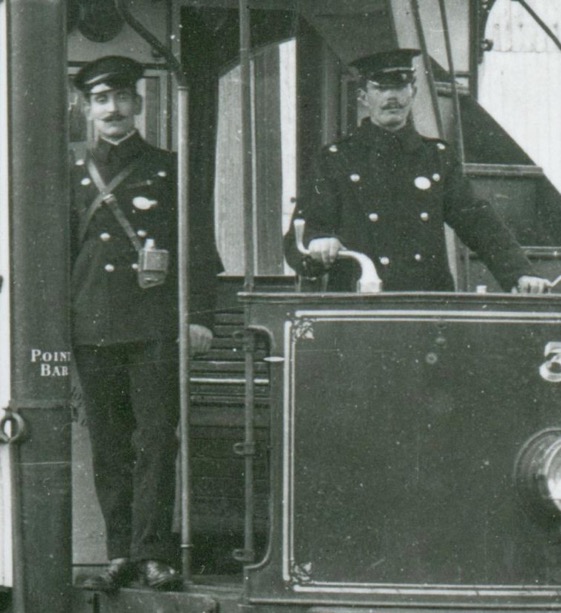
An enlargement of the above photograph showing the crew of Tramcar No 3. Although the caps and collars appear to be devoid of insignia, they do in fact carry embroidered badges (see below).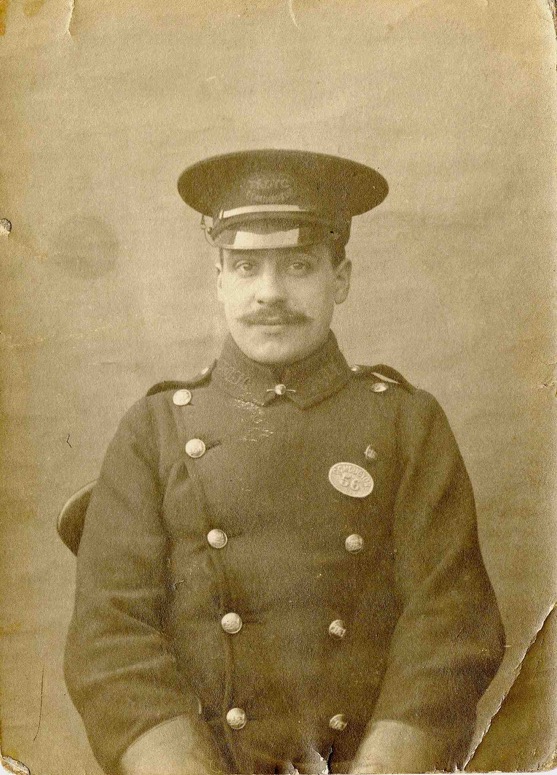
A Falkirk and District Tramways Company conductor (No 56) — photo undated, but probably taken to mark the commencement of operations in 1905. 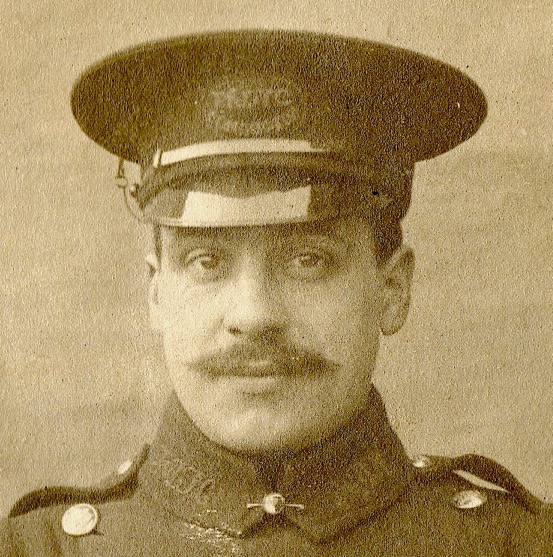
An enlargement of the above photograph showing the uniform insignia: embroidered system initials ('F&DTC') on the collars, and an oval cloth cap badge with the system initials and the bearer's grade ('F&DTC CONDUCTOR'). On magnification, the buttons appear to bear ‘F&DTC’ in script-lettering.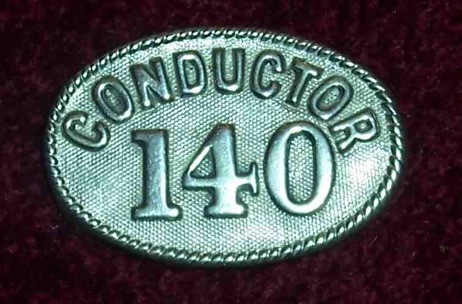
A conductor employee number badge of the type used by the Falkirk and District Tramways Company from 1905 through to circa 1910 — nickel. It is currently unclear whether these were issued in nickel or brass. Author's Collection.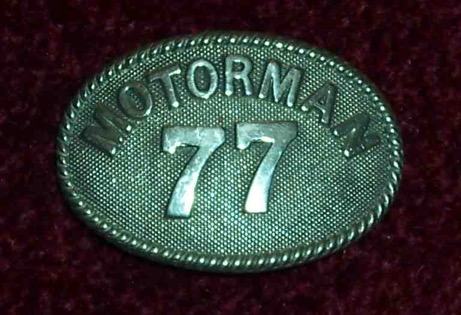
A motorman employee number badge of the pattern used by the Falkirk and District Tramways Company from 1905 through to circa 1910 — nickel. Author's Collection.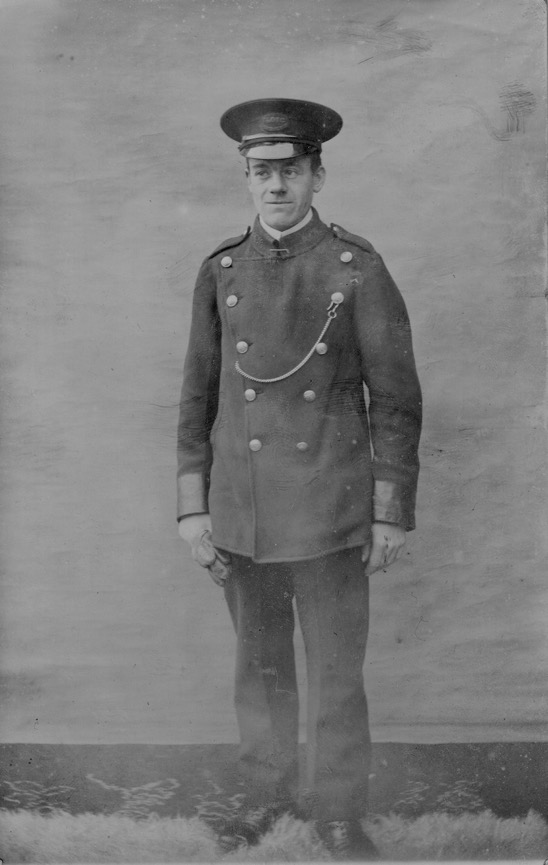
Another studio portrait of a F&DTCo conductor — photo undated, but probably taken in the mid-to-late Edwardian era. Author's Collection.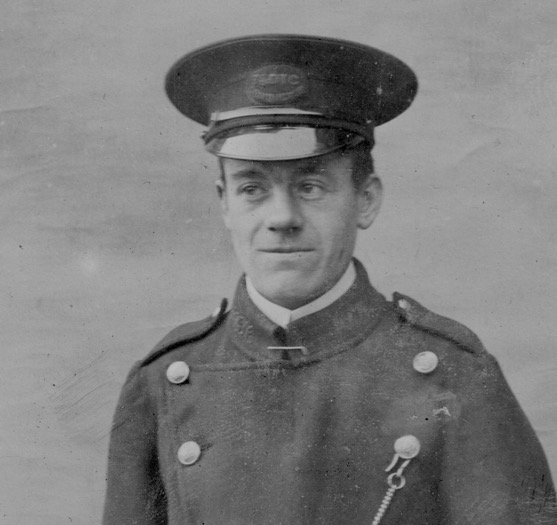
An enlargement of the above photograph showing details of the uniform jacket and cap insignia. The subject is not wearing the usual oval badge on his jacket.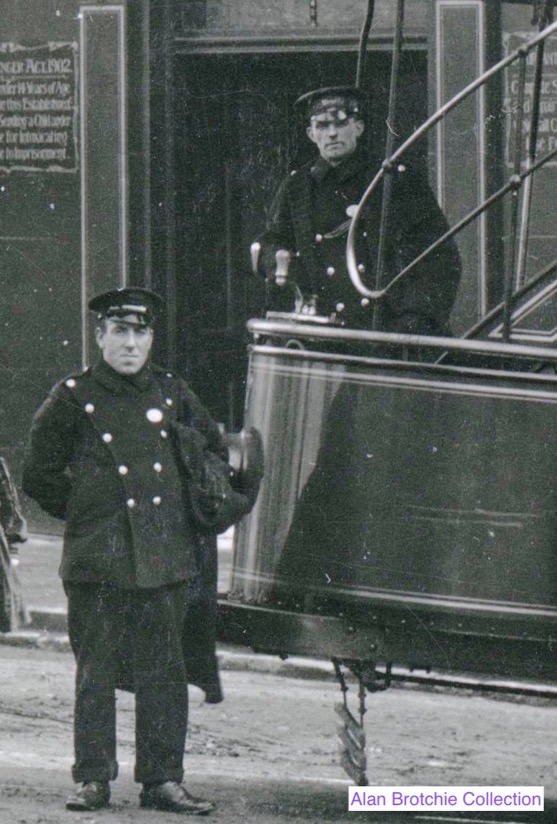
Another early shot, this time of Tramcar No 17 at Larbert Cross in November 1905. The employee number badges — worn on the left-breast of the bearer's tunic — are clearly in evidence. The motorman would appear to be wearing a script-lettering grade badge, though this is far from certain.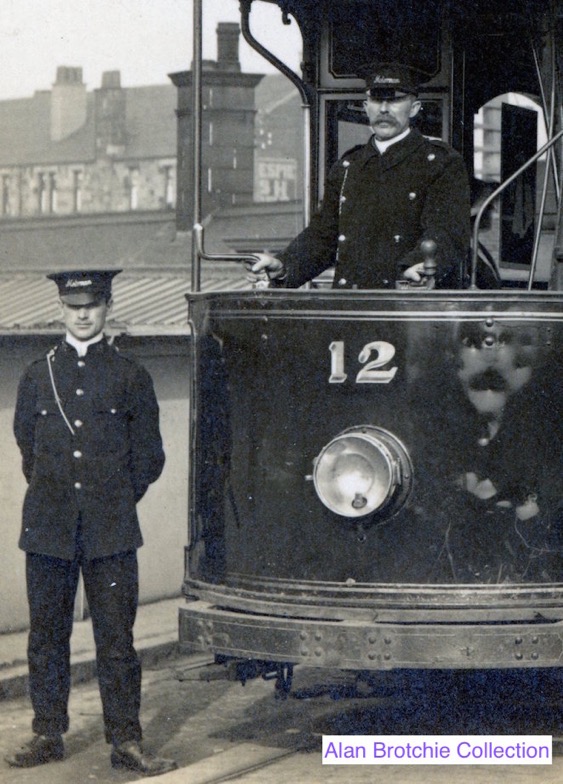
Two motormen with a rather battered looking Tramcar No 12 on Larbert Bridge — photo undated, but probably taken in the four years immediately prior to the Great War. By this time, the lancer-style tunics and cloth cap badges had been superseded, the latter by off-the-shelf grade badges.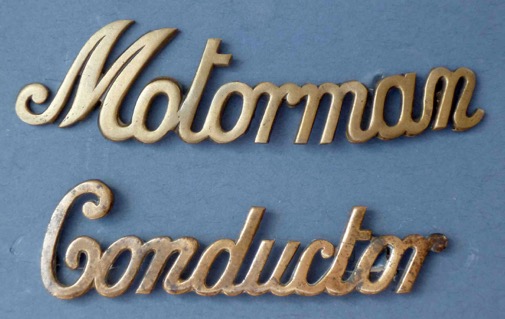
Script-lettering cap badges of the type worn by Falkirk and District Tramways Company staff from the late-Edwardian era onwards. It is currently unclear whether these badges were issued in brass or nickel. Author's Collection.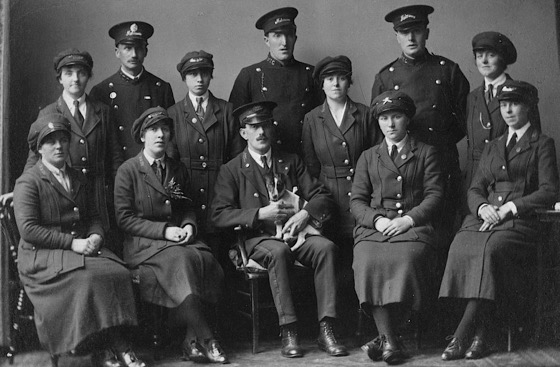
A group of three motormen, eight lady conductors and an inspector (with dog) in 1916. The motormen are wearing a new style of lancer tunic with metal 'F D T C' initials on their collars. A variety of regimental badges are also in evidence (motorman top left, conductress bottom left, and conductress 2nd from the right on the front row); this was a common practice amongst tramway staff across the UK, both during the war and for a short while afterwards. With thanks to Alan Brotchie.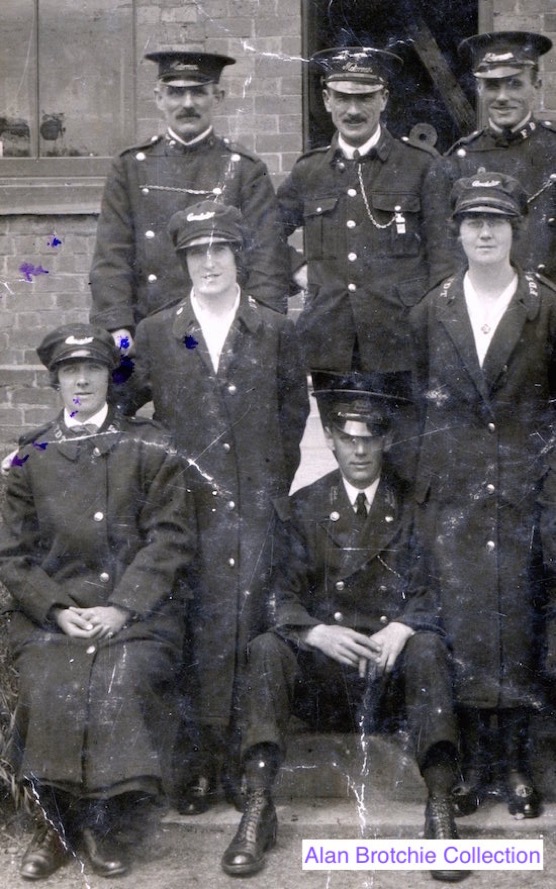
Three conductresses, three motormen and a ticket inspector — photo undated, but probably taken in the 1920s. The two outside motormen are wearing lancer-style tunics with 'F D T C' on the stand-up collars, whereas the man in the centre is wearing the older style single-breasted jacket, devoid of system initials.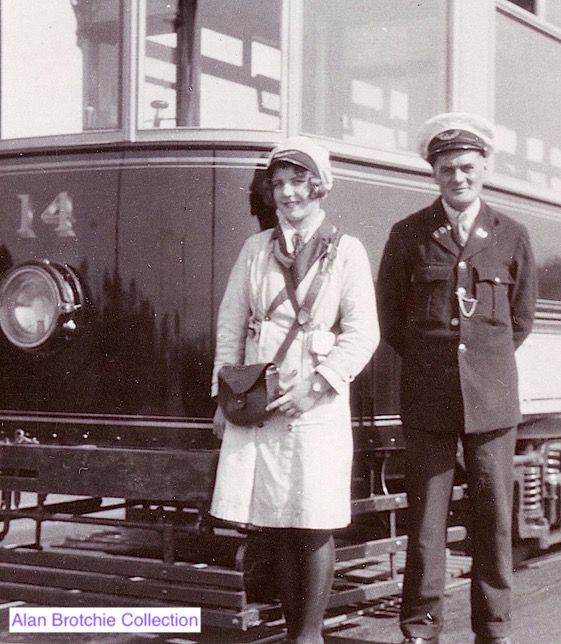
A conductress and motorman in summer wear with a new Tramcar No 14 — photo undated, but probably taken in the 1930s. The motorman is wearing the style of jacket issued late in the tramway's existence, with 'F D T' on the bearer's right-hand lapel. It is unclear what he is wearing on his left-hand lapel as other photos show this unadorned. His cap badge looks odd as well, though this may just be a curved example of the standard grade badge.
Senior staff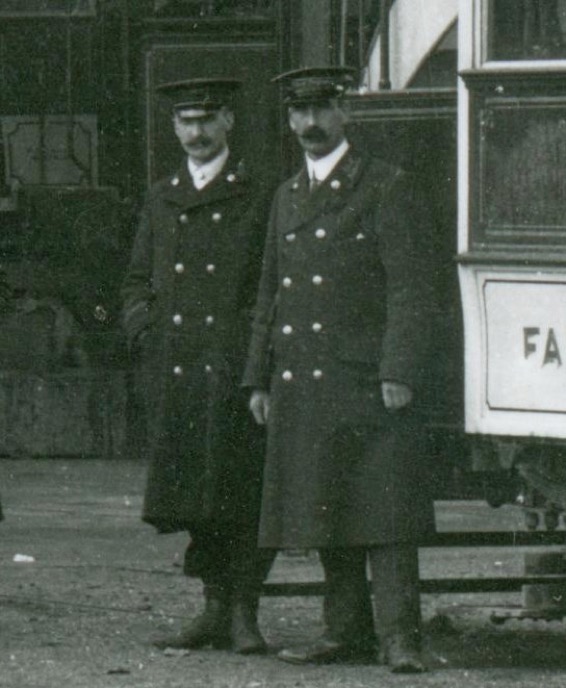
A blow-up of the opening day depot photo above showing two individuals who are in all probability inspectors. The man on the right has two lines of script lettering on his left-hand greatcoat collar.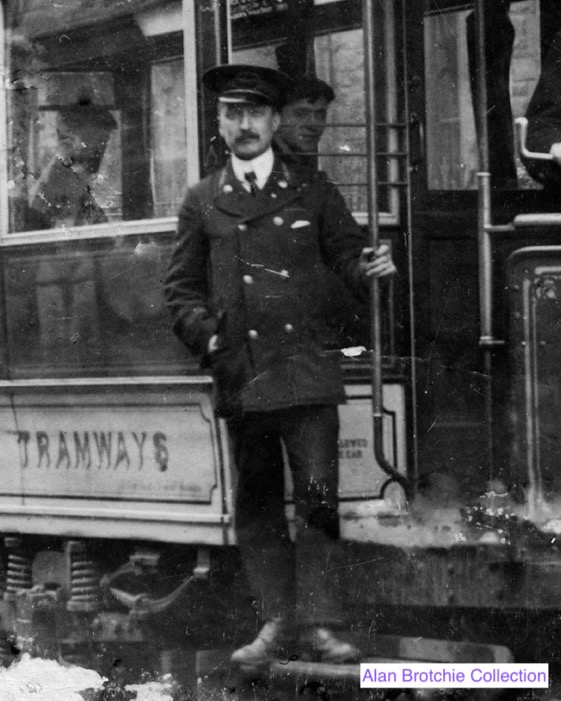
An inspector aboard Tramcar No 18 — photo undated, but probably taken in the mid-to-late Edwardian era.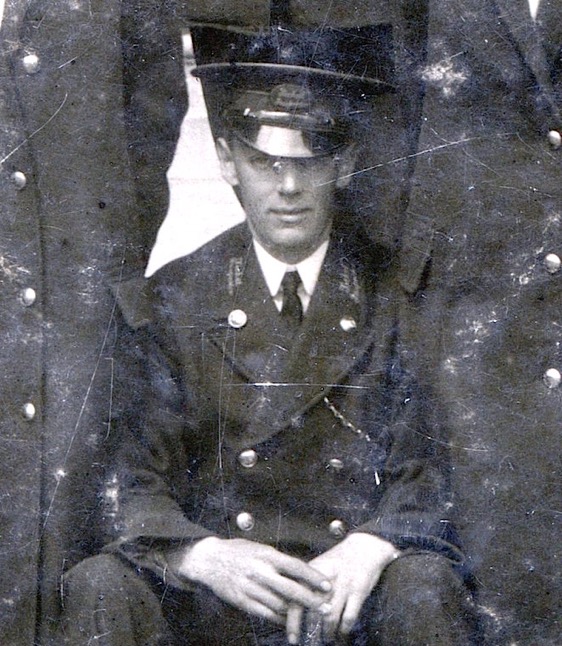
An enlargement of the 1920s group photo above showing the ticket inspector. Both the jacket collars and the cap badge carry the grade — 'Ticket Inspector' — in embroidered script lettering.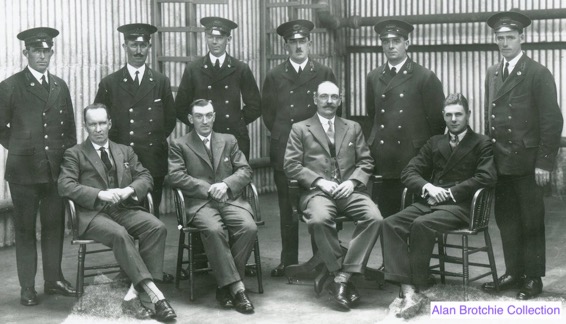
A senior staff photo, including three ticket inspectors and three chief inspectors — probably taken around 1925. It is unclear why there are three of the latter, as it was usual to only have one, though in this case, two of them could well have been dedicated to the company's sister enterprise, the Scottish General Omnibus Company.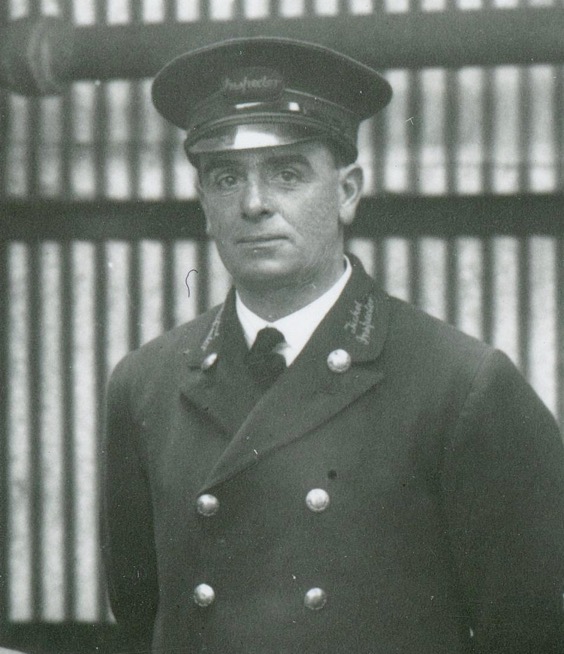
An enlargement of the above photograph showing one of the inspectors — although his collar designation is 'Ticket Inspector', his cap badge is simply 'Inspector'.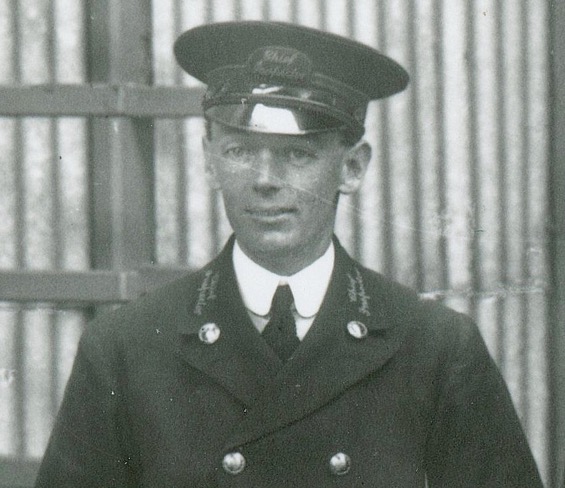
Another blow-up of the above staff photo, this time showing one of the chief inspectors — both his collar designation and his cap badge are clearly marked 'Chief Inspector'.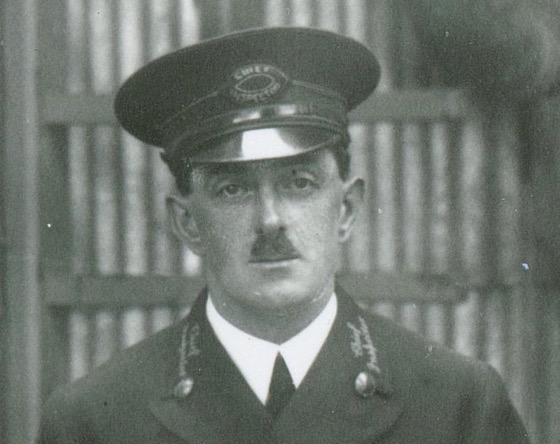
Yet another blow-up of the staff photo above — although both his collar designation and his cap badge are clearly marked 'Chief Inspector', the cap badge is a different style than the two other chief inspectors in the photograph. This may be because he was a bus rather than a tramway official.
Female staff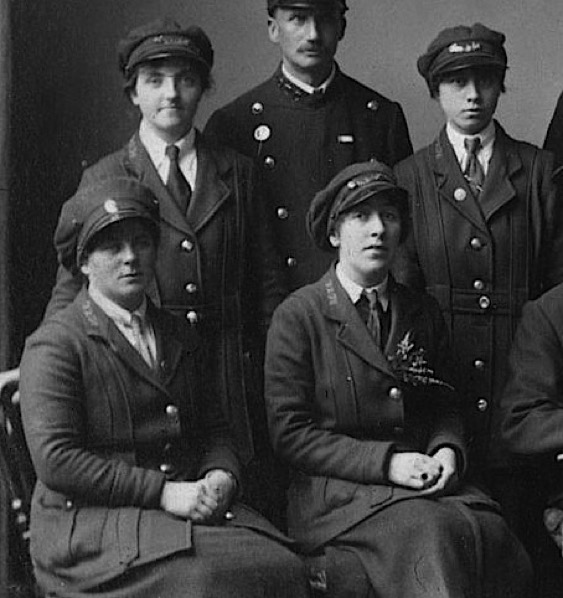
An enlargement of the 1916 photograph above showing four of the conductresses. The collar badges appear to be embroidered system initials — 'F D T C'. 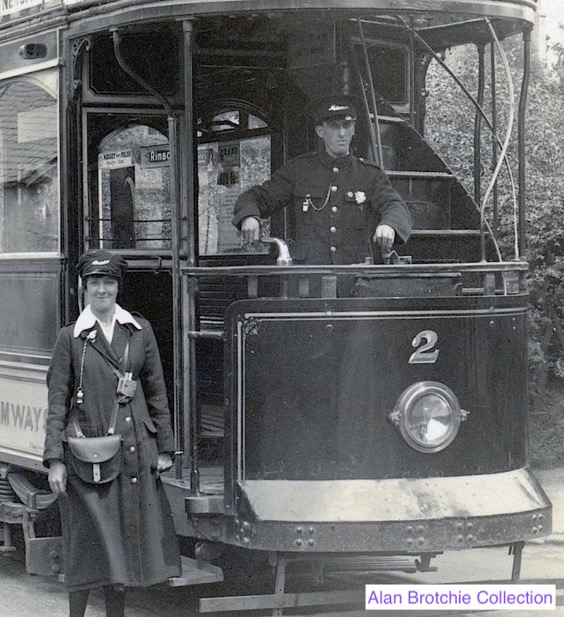
A conductress and motorman with Tramcar No 2 near Larbert Mill — photo undated, but possibly taken in the summer of 1915 when 'lady conductors' were taken on for the first time.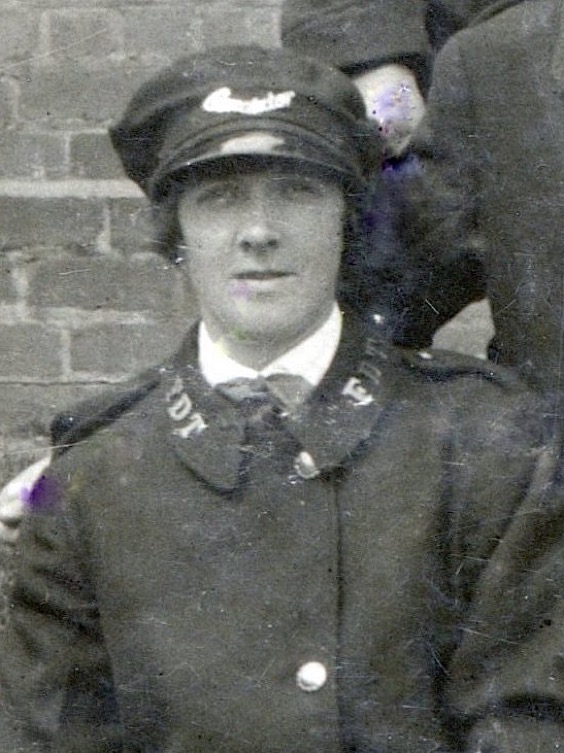
An enlargement of the 1920s group photo above showing one of the conductresses; her greatcoat collars carry individual system initials — 'F D T' —
on each side. The off-set nature of the coat buttons is easily made out, as is their design: plain, scalloped-rim issues similar to those worn by other Scottish tramway companies owned by Balfour Beatty and Company.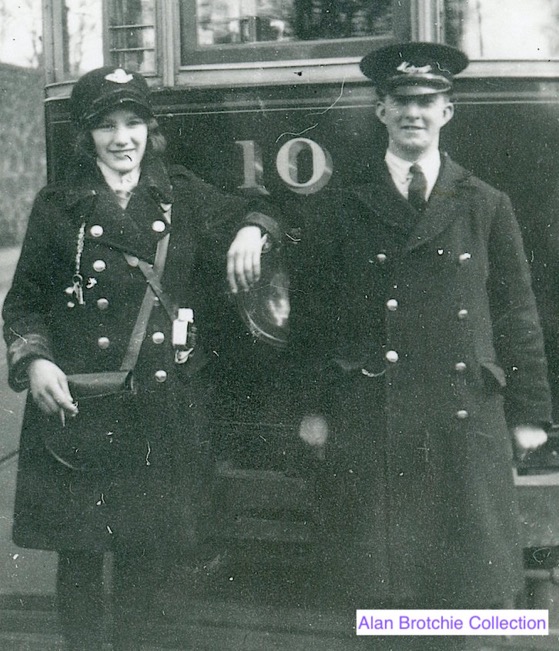
An F&DT conductress and a motorman with a rather new looking No 10, dating the photograph to around 1930. Neither of the subjects' coats appear to carry insignia. The conductress's cap badge is actually a curved, standard issue 'Conductor' badge, with a small round badge of unknown pattern (probably not a company issue) worn above it.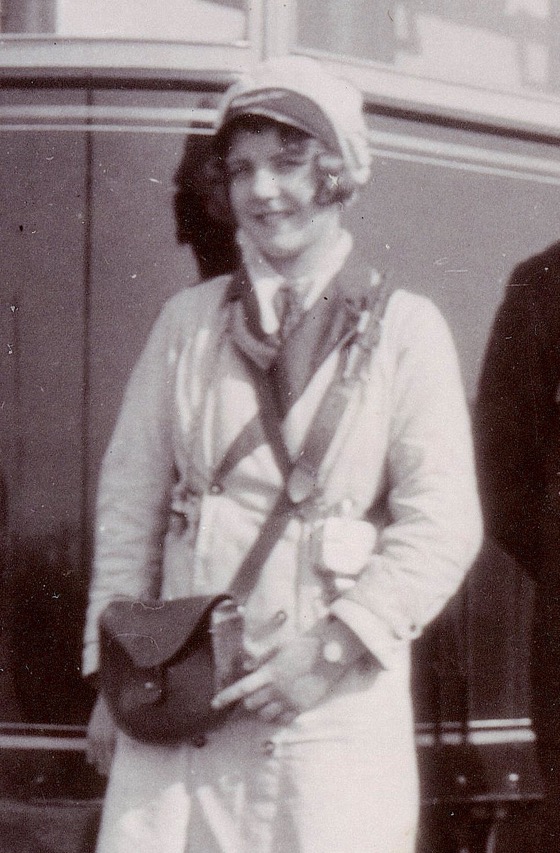
An enlargement of the mid-1930s Tramcar No 14 crew photograph above showing the conductress in her white summer dust coat.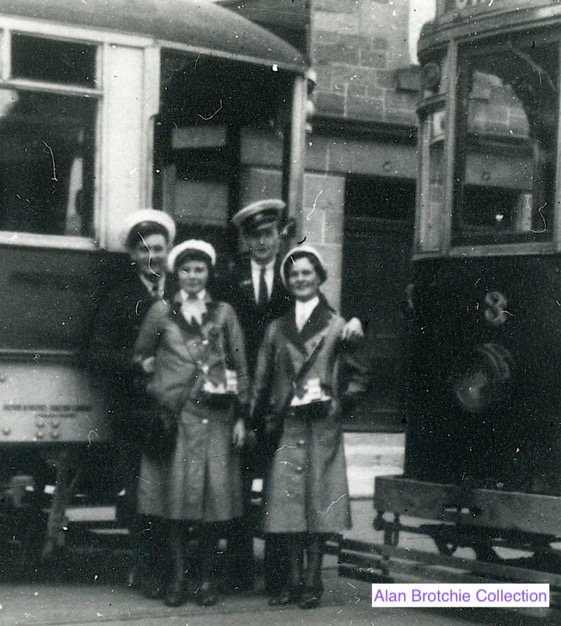
Two motormen and their conductresses with Tramcar No 3 on the last day of operation, 21st July 1936. Both ladies appear to be wearing noticeably darker-coloured coats (possibly waterproof) than in the previous photograph.